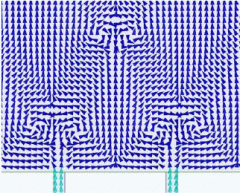September 23, 2008 feature
In radiation 'ventriloquism,' electromagnetic waves travel backwards

(�鶹��ԺOrg.com) -- Typically, electromagnetic waves travel away from their sources. For instance, a radar system emits radio waves that travel all the way to a target, such as a car or plane, before being reflected back to the source. Police officers and the military rely on the forward movement of the waves to determine the speed or location of an object.
So if electromagnetic radiation started flowing in reverse, back toward its source, it could cause serious confusion. But this is just what Cesar Monzon, a Senior Scientist at Enig Associates, Inc., in Silver Spring, Maryland, has discovered. In a recent study, he theoretically demonstrates that, under special conditions of geometry, location, and frequency, power may flow backwards in the direction of its source. The study is published in a recent issue of �鶹��Ժical Review Letters.
“I have been working in diverse aspects of electromagnetics for a number of years, and I just happened to stumble on some solutions of Maxwell’s equations that exhibited a very unusual behavior,” Monzon told �鶹��ԺOrg.com. “It is counterintuitive because we observe that, in some portions of space, the power is actually flowing back in the direction of the sources. On the other hand, based on experience, and with very rare exceptions (that involve wave guidance in exotic circumstances), the radiated power always spreads out as it travels away from the sources. For example, thermal radiation travels in straight lines away from a heat source.”
In Monzon’s theoretical set-up, a number of identical electromagnetic wave sources are aligned in a row. When they radiate power at a certain frequency, an unusual power flow pattern develops at a distance of about half a wavelength away from the sources. At this location, the power turns and flows back toward the source array, accompanied by a vortex formation.
As Monzon explains, the backwards power flow is caused by interference from the multiple sources. The waves superpose in such a way that the phase gradient of the waves points backwards in certain regions. Mathematically speaking, the electrical terms must overcome a geometric term. Monzon likens this condition to that of a mechanical object whose kinetic energy must overcome the potential energy of a barrier in order to overcome the barrier – like a ball with momentum rolling up a hill.
As Monzon notes, the backward power flow is being carried by an ordinary wave, in which the phase velocity, group velocity, and power all point in the same direction. Until now, power flowing toward its source has only been demonstrated for “backward” waves, where some of these characteristics are reversed.
But the fact that ordinary waves are flowing backwards here results in some unusual effects. If an observer were to detect the backward-moving waves, it would seem as if the waves were originating from a “ghost” source in the opposite direction from the true source. Monzon shows that it’s possible to control the placement of the backwards power flow, and harness the effect for various applications, including deception.
“On the case of deception, it appears possible that with current technology we can build a radiator (such as a radar) that can convince an observer, through measurements, that radiation is coming from a given direction, when in reality we are somewhere else, and perhaps even observing them,” he said. “The effect is real, not an illusion. The resulting effect on the observer is, however, akin to the illusion offered by a ventriloquist who manipulates his or her voice so that it appears that the voice is coming from elsewhere.”
Monzon added that the phenomenon could also be applied to other areas, such as optics, acoustics, and water wave problems.
“On the case of satellite antenna feeds, the theory indicates it may be possible to build these behind the main reflector dish, which will offer a clear field of view without blocking or the disadvantages derived from feed offsetting,” he explained. “The same principle applies to both transmit and receive antennas.”
More information: Monzon, Cesar. “Anomalous Power Flow and ‘Ghost’ Sources.” �鶹��Ժical Review Letters 101, 083901 (2008).
Copyright 2008 �鶹��ԺOrg.com.
All rights reserved. This material may not be published, broadcast, rewritten or redistributed in whole or part without the express written permission of �鶹��ԺOrg.com.





















